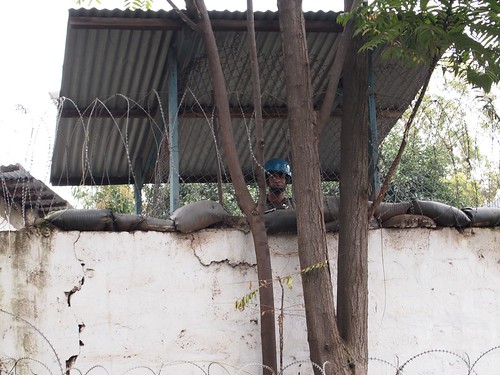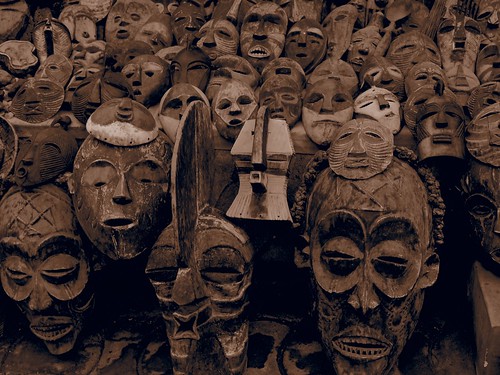These photographs were taken on 29 April 2012 and show a quiet city on a Sunday. But such calm belies many tragic days in the past and a possibly deadly future. You may note the amount of lava on the roads and stone fences. In 2002 nearby Nyiragongo Volcano erupted and pushed a swath of lava through Goma. The lava was about 2 meters thick and ranged from 200 meters to one kilometer wide. Fortunately most city dwellers got notice and fled, but some died from asphyxiation. Almost half of the homes in Goma were destroyed.
But that probably was not as traumatic as the ten years of war that pounded the Goma area. And even after the war officially ended in 2003 this area has continued to have outbreaks of violence.
For the past few weeks there has been significant violence 20 to 30 kilometers from Goma. A group of mutineering soldiers (who once were part of a rebel group known as CNDP and who had been integrated into the Congolese army) have been fighting with their former compatriots– the Congolese army. Perhaps as many as 20,000 people have left their homes and villages to flee from the violence. The leader of the mutiny is Bosco Ntaganda who was once a general in the Congolese army and who has an outstanding warrant issued by the International Criminal Court.
People fleeing violence is nothing new for the people of Goma. For example, during the Rwanda genocide, for two days in July 1994 as many as 10,000 people per hour crossed the border into Goma.
And then there is the future. Goma sits beside beautiful but potentially deadly Lake Kivu. As a deep lake (500 meters) with nearby volcanoes (feeding the lake with carbon dioxide saturated water) it is one of three known lakes in Africa which have the potential to kill large numbers of people and animals. Large volumes of carbon dioxide sit in the depths of the lakes and if the right combination of events occurs the lakes can release huge clouds of the deadly gas. In 1986 Lake Nyos in Cameroon did just that resulting in the asphyxiation of more than 1,700 people.
Lake Kivu is 2,000 times larger and also has methane along with carbon dioxide stored in it’s depths.
Paradise always has an edge.
Update March 2013: a story in The Economist published January 12th said this:
“Soaked in carbon dioxide and methane from surrounding volcanoes, Kivu is one of the world’s most explosive lakes. If it’s gases were suddenly released the explosion (a “turnover”, in geology-speak) could be “the biggest catastrophe humankind has experienced,” perhaps suffocating or incinerating the 2m people who live on the shore, says Jarmo Gummerus, a Finnish engineer.”
Perhaps ironically, or perhaps sadly, that Finnish engineer is himself working on a barge floating on Lake Kivu. He is part of a Rwandan project to extract methane from the lake to use in the production of electricity. The first phase of that project has $140,000,000 of investment behind it. And there’s more coming for the second phase if Rwanda can convince the international community that it really wasn’t supporting the rebellion last year in the Congo. A denial that’s not so easy to make.
Sometimes I think we humans are a bit mad.
We have a lake that could explode at any time. Not far from it’s shores in the DRC there has been fighting for much of last year. That included the rebels taking control of Goma until they decided that negotiations might work. But during 2012, thousands fled the Goma area and are now refugees. More sadly, murder, rape and abduction of children to make them soldiers continued in the region northwest of Lake Kivu.
And yet, the Finnish engineer continues to farm methane from the depths of Lake Kivu to make electricity for Rwanda.
It seems to me it’s like trying to salvage the scrap metal from an atomic bomb that failed to detonate.











